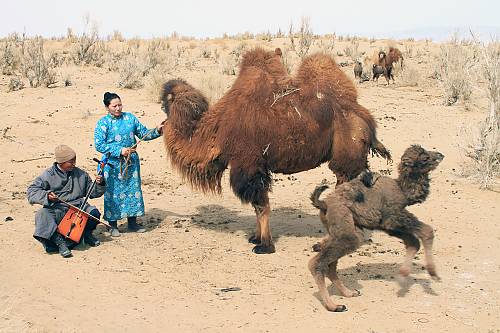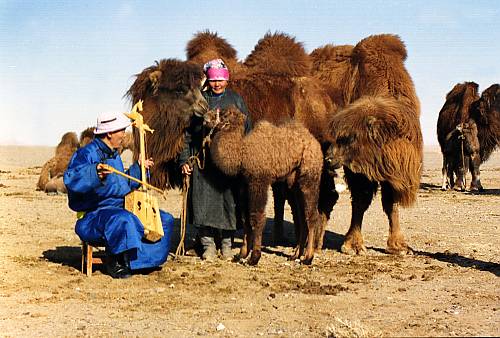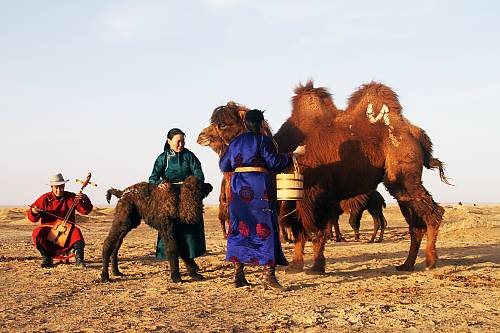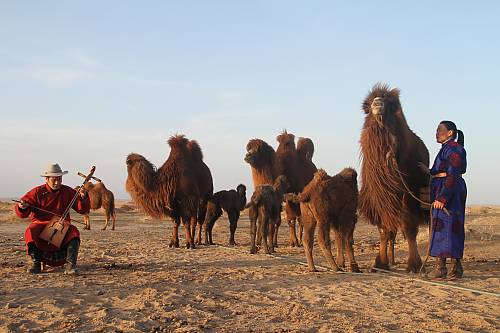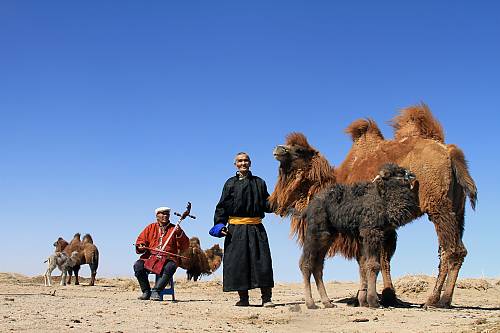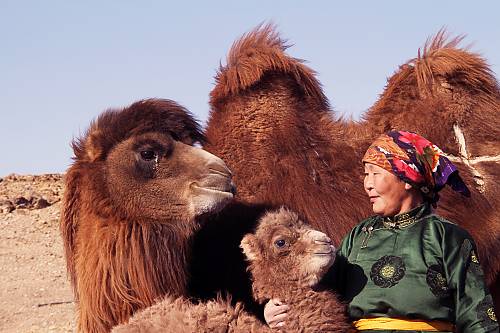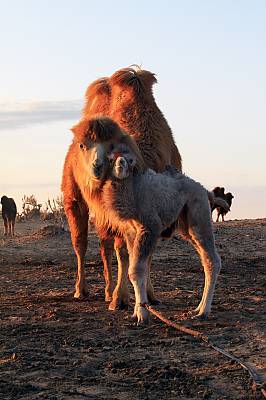Rapport sur l'état d'un élément inscrit sur la liste du patrimoine culturel immatériel nécessitant une sauvegarde urgente
A. Page de couverture
A.1.
État partie
Nom de l'État partie
Mongolie
A.2.
Date du dépôt de l'instrument de ratification, d'acceptation, d'approbation ou d'adhésion
Elle peut être consultée en ligne.
Date of deposit of the instrument of ratification, acceptance, approval or accession
2005-06-29
A.3.
Élément inscrit sur la Liste de sauvegarde urgente qui fait l'objet du présent rapport
Nom de l'élément
Coaxing ritual for camels
Inscrit en
2015
État(s) soumissionnaire(s)
Mongolie
A.4.
Période considérée dans le présent rapport
Veuillez indiquer la période couverte par le présent rapport.
A.5.
Autres éléments inscrits sur la Liste de sauvegarde urgente, le cas échéant
Veuillez établir une liste de tous les autres éléments présents sur le territoire de votre pays qui sont inscrits sur la Liste de sauvegarde urgente et indiquer en quelle année ils y ont été inscrits ; pour ce qui est des éléments multinationaux, veuillez indiquer quels autres États sont concernés.
Other elements inscribed on the Urgent Safeguarding List, if any
La calligraphie mongole (2013)
La musique traditionnelle pour flûte tsuur (2009)
La technique d’interprétation du chant long des joueurs de flûte limbe – la respiration circulaire (2011)
Le Biyelgee mongol, danse populaire traditionnelle mongole (2009)
Le Tuuli mongol, épopée mongole (2009)
Les pratiques traditionnelles mongoles de vénération de sites sacrés (2017)
A.6.
Synthèse du rapport
Veuillez fournir une synthèse du rapport, qui permette au grand public de comprendre l'état actuel de l'élément, mentionne toute incidence positive ou négative de son inscription et fasse état des mesures de sauvegarde mises en œuvre pendant la période considérée et leur possible mise à jour les années suivantes.
A.7.
Personne à contacter pour la correspondance
Donnez le nom, l'adresse et les coordonnées d'une personne à qui toute correspondance concernant le rapport doit être adressée.
Titre (Mme/M., etc.)
Nom de famille
Prénom
Institution/fonction
Adresse
Numéro de téléphone
Adresse électronique
Autres informations pertinentes
B. État de l'élément inscrit sur la Liste de sauvegarde urgente
Veuillez vous référer au dossier de candidature ou aux précédents rapports, le cas échéant, pour savoir quand établir un rapport sur l'état actuel de l'élément et ne rendez compte que des changements pertinents survenus depuis la date de son inscription sur la Liste ou depuis le précédent rapport. Les dossiers de candidature, les calendriers spécifiques et les précédents rapports, le cas échéant, sont disponibles à l'adresse suivante : https://ich.unesco.org ou peuvent être demandés au Secrétariat.
L'État partie s'efforce de prêter une attention particulière au rôle du genre et d'assurer la plus large participation possible des communautés, des groupes et, le cas échéant, des individus concernés ainsi que des organisations non gouvernementales pertinentes pendant le processus de préparation de ce rapport ; il lui est demandé au point D ci-dessous de décrire de quelle manière il y est parvenu.
B.1.
Fonctions sociales et culturelles
Expliquez les fonctions, les significations sociales et culturelles de l'élément aujourd'hui, au sein et pour ces communautés, les caractéristiques de ses détenteurs et de ses praticiens et décrivez, entre autres, toute catégorie de personnes exerçant un rôle ou des responsabilités spécifiques vis-à-vis de l'élément. Une attention particulière devrait être accordée à tout changement pertinent susceptible d'avoir des répercussions sur le critère d’inscription U.1 (« L’élément est constitutif du patrimoine culturel immatériel tel que défini à l'article 2 de la Convention »).
Social and cultural functions
Mongolian herdsmen perform a ritual called the Coaxing ritual to strengthen the bond between mother animals and their newborns. It involves using special words and melodies to encourage the mother to accept her baby and is particularly important for camels. According to article 2.2 of the Convention for the Safeguarding of Intangible Cultural Heritage, this heritage element belongs to the domain of “oral traditions and expressions, including language as a vehicle of the intangible cultural heritage”, “Social practices, rituals and festive events” and domain “performing arts” and domain “knowledge and practices concerning nature and the universe”.
The coaxing ritual unique form of intangible cultural heritage, because it is the way of adopting a newborn orphan and rejecting a baby by its mother. It is the ritual of singing and playing musical instruments with psychological communication of herdsman and animal through consonant melody for adopting baby camel.
An inscription of this heritage element on the List of Intangible Cultural Heritage in Need of Urgent Safeguarding, UNESCO has played a significant social and cultural role not only to practitioners and herders but also for all Mongols to be proud of their nomadic lifestyle and understand that traditional methods and cultural heritage are an integral part of their life and importance to transmission to youth.
While elsewhere spring is a pleasant season for peasants, it isn’t convenient for Mongolian herdsmen. Every 2 years, mother camel gives birth to their young in a harsh and dusty spring, so there is a big risk of losing a mother or a baby animal. Therefore, tying the mother camel and orphaned baby camel using this ritual practice and knowledge is one of the factors that keep the camel population in our country from declining.
The most important role played in the Coaxing ritual is experienced by herders singers women and musicians, who will have psychological contact with animals, through the lyric melody. While the children are learning from the older generation how to perform the ritual, they will have information and knowledge on the traditional behavior of nomads to love and respect elders and to protect the natural environment. As one of the unique relationships of humans to animals and the environment, the Coaxing ritual is very suitable for the sustainable development of Mongolia, because of a unit of cultural bearers and practitioners, their communities, and groups to safeguard the ritual.
Camel herders, communities of cultural bearers and practitioners, and groups of elders and supporters are the main actors in the continuity of the Coaxing ritual as a useful practice of camel raising and an unforgettable tradition of human/ animal relationship of nomads in the future.
B.2.
Analyse de sa viabilité et risques auxquels il est actuellement exposé
Décrivez le degré actuel de viabilité de l'élément, en particulier la fréquence et l'étendue de sa pratique, la vigueur des modes de transmission traditionnels, la composition démographique des praticiens et des publics, et sa durabilité. Veuillez aussi identifier et décrire les facteurs qui, le cas échéant, constituent une menace pour la pérennité de la transmission et de la représentation de l'élément et indiquez le degré de gravité et de proximité de tels facteurs, en accordant une attention particulière à tout renforcement ou affaiblissement de la viabilité de l'élément suite à son inscription.
Assessment of its viability and current risks
Today, this element is being practiced in Dundgovi, Umnugovi, Dornogovi, Govisumber, Gobi-Altai, Bayankhongor, Uvs, and Khovd, Dornod, Tuv, Uvurkhankgai, and Khuvsgul provinces.
As of 2022, the Govisumber province has a total of 1007 camels and coaxing ritual is being practiced in this province. Herders herd camels for four seasons of the year and get benefits from camels for four seasons.
Dundgovi province has a total of 41138 camels and herders in the south of the territory are herding camels along with pasture areas. Dundgovi province has a total of 15 soums and only 3 practitioners identified and inventoried in 3 soums and the viability of this element is very weak in this province.
Tov province has a total of 3975 camels and there are a total of 7 practitioners identified and inventoried 5 soums.
Uvs province has a total of 27234 camels and only 3 practitioners inventoried at the Zavkhan soum of Uvs province, traditional knowledge and practice associated with herding camel is on the edge of disappearance and it is important to increase the number of practitioners in this province through apprenticeship training.
Khuvsgul province has a total of 2507 camels, and after the inscription of the element on the USL, the number of camel herders increased. With the increase in camel number, revitalization of camel load and nomad migration practices occurred.
Bayankhongor province has a total of 45529 camels 17457 of them are female camels and several camels are increasing year by year. Elder practitioner Sh.Tseveen was included in the “National List of Intangible Cultural Heritage Practitioners” in 2019 because she practiced coaxing ritual for camels. In Bayanlig soum of Bayankhongor province, there is a total of 10 practitioners inventoried.
Ovorkhangai province has a total of 19,300 camels, only practitioners D.Dorj and his family members are representing this element in their province.
Khovd province has a total of 29557 camels but no practitioners inventoried.
Omnogovi province has a total of 164766 camels, but only 14 practitioners are inventoried.
Although the viability of the element “Coaxing ritual for camels” is enhanced, the number of herders is being decreased, and the following risks still exists. As for including:
1. The number of herders who herd camel is less
2. Camel herding practice is uncommon or unidentified in mountainous areas
3. Camels are being used for domestic uses for loading and riding
4. The environment where to herd and increase camel is less.
These statistics from the local community show that the environment for practicing this type of heritage element is shrinking more and more. The number of herders in rural areas is decreasing due to the sharp increase in population migration from rural to urban areas. Due to this, transmission of knowledge and practices associated with coaxing ritual is being lost and negative impacts occurred in the sustainable development of traditional pastoralism.
As well as, due to the mining development in Gobi area young camel herders are willing to drive lorries to get more income.
B.3.
Mise en œuvre des mesures de sauvegarde
Veuillez rendre compte des mesures de sauvegardes qui ont été décrites dans le dossier de candidature et dans un précédent rapport, le cas échéant. Décrivez de quelle manière elles ont été mises en œuvre et ont contribué de façon substantielle à la sauvegarde de l'élément au cours de la période considérée, en tenant compte des contraintes externes ou internes telles que des ressources limitées. Incluez en particulier des informations sur les mesures prises afin d'assurer la viabilité de l'élément en permettant à la communauté d'en poursuivre la pratique et la transmission. Fournissez les renseignements suivants en ce qui concerne la mise en œuvre de l’ensemble des mesures de sauvegarde ou du plan de sauvegarde :
B.3.a.
Objectifs et résultats
Indiquez quels objectifs principaux ont été atteints et quels résultats concrets ont été obtenus pendant la période considérée.
Objectives and results
Practitioners of Omnogovi, Dundgovi, Dornogovi province attended the “Nomadic Mongolia-2022” intangible cultural heritage festival. In addition, the Natural History Museum organized activities to promote the element during this festival.
Due to the COVID-19 pandemic and natural and economic circumstances, the formal and informal training was canceled, even though, online podcasts for raising awareness organized and experts from relevant departments of the relevant ministries delivered presentations.
Activities planned to be implemented within the objective to support camel households to have horse fiddle, flute, and Jew harp and develop family members’ skills of coaxing and playing on the musical instruments could not fulfilled due to the Covid-19 pandemic and natural and economic circumstances.
In 2020, the Omongovi province gave a “Certificate of Honour” to practitioners O.Batjargal, Kh.Khuukhenduu for giving a contribution to the safeguarding of this heritage element. In 2022, the Bayankhongor province gave awards “Most Talented Practitioner” to practitioners Danzan and Tseven for practicing the element in a high level of skills and practices.
In addition, the Ministry of Food, Agriculture and Light Industry is giving rewards annually to herders who are selected among others, by following criteria such as herding their livestock by the traditional way of herding, giving a special contribution to the increase of camel numbers by their administration units.
Not only Gobi region, but also in the western region including Khovd, Uvs, and Govi-Altai provinces, safeguarding measures such as revitalization, promotion, and training workshops organized for enhancing the viability of the “Coaxing ritual for camels”. In addition, aiming to expand the distribution of this heritage element in other areas, provincial, regional, and national “Consultative meetings for camel herders” have been organized in Khovd, Bayankhongor, and Omnogovi provinces.
Govi-Altai province has organized training for cultural heritage specialists on the theme “Safeguarding of intangible cultural heritage” and carried out research and documentation. Dundgovi province has made documentation of the “Coaxing ritual for camels” from a young herder family. Govisumber Province identified 4 practitioners and inventoried and documented them. Ovorkhangai province carried out a preliminary survey on the identification of practitioners and made inventorying and documentation for practitioners in Togrog soum.
In 2020, the National Center for Cultural Heritage organized an online training workshop for specialists and cultural center directors in the Gobi region on the theme “Improving the inventorying and documentation of intangible cultural heritage” and the documentation methodology and technique given to the aforementioned specialists in the case element.
In 2022, training was organized for the director of 14 cultural centers of Omnogovi province on the theme “Coaxing ritual for camels” and a documentary film was shown and methodology given to promote this heritage element. As a result of this work, cultural heritage specialists in the local area have experience in inventorying and documenting this heritage element.
“Camel festivals” are being supported by the Ministry of Culture, the Ministry of Environment and Tourism, the Ministry of Food, Agriculture and Light Industry, and the Local Governing Administration.
In 2023, “Camel Culture Cabinet” was founded in Dundgovi Province museum.
B.3.b.
Activités de sauvegarde
Dressez la liste des principales activités menées au cours de la période considérée pour obtenir ces résultats escomptés. Veuillez décrire les activités en détail en mentionnant leur efficacité et tout problème rencontré dans leur mise en œuvre.
Safeguarding activities
“Camel is sky animal” educational program and hand drawing competition organized in Dundgovi province.
Provincial, regional, and national festival called “Camel Festival” is annually organized in Dundgovi, Omnogovi, Govi-Altai, Bayankhongor, Khovsgol province. During these festivals, several competitions for different ages of camels, presentations of coaxing rituals, attractive couples with beautiful camels, camel parades, local camel wool products, handicraft exhibitions, and dairy product exhibitions are organized and herders attend.
A national consultative meeting “Camel is Sky Animal 2020” was organized in Bogd soum of Bayankhongor province and during this consultative meeting, the “Camel Festival” was also organized. Practitioners and representatives of government and non-governmental organizations attended the meeting from Bayankhongor, Omnogovi, Ovorkhangai, Govi-Altai, and Khovd provinces.
The local administration of the Dundgovi province has paid much effort to the safeguarding of this heritage element. For instance, aiming to increase the number of camels, Dundgovi province has allocated incentives to those herders who herd camels, gave support to the organization of camel festivals, and organized multifaceted activities in the territory of the province. As a result of these activities, the transmission of this heritage element was sustained, and apprenticeship training for coaxing ritual, apprenticeship training of folk long song and horse head fiddle conducted, and camel events and festivals were organized regularly.
A consultative meeting of camel herders in Khovd province was organized in April of 2022, in cooperation with the Citizen’s Representative’s Khural of Khovd Province, Local Governing Administration of Khovd Province, Food and Agricultural Agency, Citizen’s Representative’s Khural of Mankhan soum, Local Governing Administration of Mankhan soum. In this consultative meeting, practitioners of this heritage element and camel herding practices attended from 17 soums of Khovd province and had discussions on troubles faced in the herding of camels, advantages, and possibilities associated with camel herding.
- In December 2022, a national consultative meeting of camel herders and camel racing was organized in Omnogobi province. A total of 112 representatives from government, non-governmental organizations, research institutes, and camel herders from Omnogovi, Dundgovi, Dornogovi, Bayankhongor, and Ovorkhangai provinces attended this consultative meeting and shared experiences on an increasing number of camels and benefits from camels.
Good practices to allocate monetary incentives for raising baby camels developed in Omnogovi, Dundgovi, Dornogovi, and Khovd provinces.
The local museum of Ondorshil soum of Dundgovi province established a new cabinet for camels in 2023 to promote the culture associated with camels and within the educational program, the coaxing ritual for camels is being taught for children.
B.3.c.
Participation de communautés, de groupes ou d'individus aux activités de sauvegarde
Veuillez décrire de quelle manière les communautés, les groupes ou, le cas échéant, les individus ainsi que les organisations non gouvernementales pertinentes ont participé de façon effective à l'exécution des mesures de sauvegarde, y compris en termes de rôles du genre. Décrivez le rôle joué par l'organisation ou l'organe chargé de l'exécution (dénomination, informations de référence, etc.) et les ressources humaines qui ont été mises à disposition pour la mise en œuvre des activités de sauvegarde.
Participation of communities, groups or individuals in the safeguarding activities
In Article 34 of the Protection Law on the Cultural Heritage, the rights and obligations of the practitioner have been first time defined, such as in the para 34.1.1. it states that “to receive financial support to protect, transmit and recreate the intangible cultural heritage, under the necessary circumstances", on para 34.2 “to teach students and transmit intangible cultural heritage to the next generations; to disseminate and promote intangible cultural heritage; to provide assistance to record information and conduct registration of intangible cultural heritage”.
The herders themselves are reviving and transmitting this heritage traditions related to mother and baby camel, while actively promoting this heritage to the public, passing it on to their children, and conducting apprenticeships.
For instance, 12 practitioners in 9 families who are practicing this heritage element of 5 generations of Daanyam in Mandal-Ovoo soum of Omnogovi province, elder practitioner Dugerkhuu and her children, 6 families including children of S.Tsenddoo herder in Khanbogd soum, P.Batsaikhan and his family in Tsogt-Ovoo soum, horse head fiddler B.Tuvden and his family in Delgerkhangai soum of Dundgovi province, camel herding community in Bayanlig soum of Bayankhongor province including practitioners Danzan, Tseveen, Dagdulamm Bayasgalan, practitioners B.Tomormonkh, N.Enkhbaatar, L.Otgonbaatar, B.Yeroolt in Govi-Sumber province, practitioner Dorj in Ovorkhangai province played an active role in the safeguarding of this heritage element during this reporting period.
Media organizations have increased their desire and initiative to cooperate with the practitioners, community, governmental and non-governmental organizations in publicizing and popularizing activities. For instance: The state regional competition “Camel is Sky Animal” organized in 2020 and during this competition, a state consultative meeting was organized and representatives of 27 soums in 5 provinces attended.
Uvs province organizes the “Ten Thousand Camel’s Festival” in every year with the cooperation of the Local Governing administration of Zavkhan soum, the Cultural Center of Zavkhan soum, and practitioners and local people.
Over 1000 persons attended in the “Camel Festival” organized in Khovsgol province.
B.3.d.
Calendrier
Indiquez, sous forme de calendrier, les dates de mise en œuvre de chacune des activités.
Timetable
Although, the 5 years national program “Safeguarding of Intangible Cultural Heritage” was approved by the 68th Resolution of the Government in 2019, due to the impact of the Covid-19 pandemic Mongolia has moved to a high level of disaster preparedness, and any cultural activities were cancelled between 2020-2022. In order not to disrupt the safeguarding activities for this heritage element in that pandemic situation, activities are organized online.
- To safeguard traditional knowledge and practice associated with coaxing ritual, and to strengthen the viability of 2019-2023
- To promote and reward practitioners of this heritage element 2019-2023
- To organize a regional meeting for camel herders and practitioners of this heritage element 2019-2023
- To improve the registration and information database, and inventorying and documentation 2019-2023
- To conduct capacity-building training and seminars for ICH specialists and practitioners of this heritage element 2019-2023
- To create sustainable management and strengthen multifaceted cooperation 2019-2023
B.3.e.
Dépenses budgétaires
Veuillez fournir le détail des montants des fonds utilisés pour la mise en œuvre de chaque activité (si possible, en dollars des États-Unis), en indiquant dans chaque cas l’origine du financement (sources gouvernementales, contributions en nature des communautés, etc.).
Budget
The Law on the Protection of Cultural Heritage was amended in 2014 by the State Great Khural of Mongolia and article 41 of the law states that "funding of cultural heritage shall come from the state budget, local budget, funds provided by Mongolian and foreign citizens, international organizations, legal entities, donations, assistance, and other sources” on the article 14, para 14.1.10. it stated that "141.1.10.to reflect in the state budget per annum the measures to protect and restore authenticity and integrity of the immovable historical and cultural memorials registered in the preliminary list of World Heritage and the World Heritage List, and to protect and strengthen the viability of intangible cultural heritage registered in UNESCO's Representative List and the List of Intangible Cultural Heritage in Need of Urgent Safeguarding, for protection, and implement them”. In addition, on the article 15 “Citizens' Representatives Khurals of aimags, soums, the Capital city, and districts shall have the following common powers concerning the protection of cultural heritage”, para 15.1.1. it has stated that “to approve medium term policy and main directives to protect cultural heritage within their territory”, on the article 16 “The Governors of aimags and the Capital city shall have the following powers concerning the protection of cultural heritage”, on the para 16.1.12. it has stated that “to identify bearers of intangible cultural heritage, as well as provide publicity and assistance and organize activities of transmission”. Indeed, these articles enable possibilities to spend local budget for safeguarding intangible cultural heritage.
Bayankhongor province:
- Within the reporting period, a total of 15.900.000 MNT was spent on the organization of the camel festival.
- According to article 4.1.4 of the contract made between the Minister of Culture, Mongolia, and Local Governor of Bayankhongor province in 2023, and article 39.2 of the Law on the Protection of Cultural Heritage, the element “Coaxing ritual for camels” presented in the “Nomads” world cultural festival and total of 40.000.000 MNT has spent.
Uvs province:
- For supporting camel herders in Uvs province, a total of 8.000.000 MNT was spent in 2023.
Khovsgol province:
- For promoting the heritage element for the public, a total of 20.000.000 MNT has been spent.
B.3.f.
Efficacité globale des activités de sauvegarde
Procédez à une évaluation globale de l'efficacité des activités menées pour parvenir aux résultats escomptés et de l'utilisation des fonds nécessaires à leur mise en œuvre. Veuillez indiquer de quelles manières les activités ont contribué à l’obtention des résultats et si d'autres activités auraient été mieux adaptées à cette fin. Indiquez aussi si les mêmes résultats auraient pu être obtenus avec de moindres ressources financières, si les ressources humaines disponibles étaient appropriées et si les communautés, groupes et individus concernés auraient pu participer davantage.
Overall effectiveness of the safeguarding activities
- Certain progress has been made in the creation of a normal and stable system for revitalizing, safeguarding, developing, training, studying, and promoting the ICH.
- Increasing the initiative and participation of practitioners, individuals, communities, groups, and non-governmental organizations in the activities associated with the safeguarding, promotion, and transmission of intangible cultural heritage increased in cooperation with the state central organization responsible for culture, local, and cultural organizations.
- The willingness and initiative of media organizations to cooperate with the practitioners, communities, and governmental and non-governmental organizations in promoting and disseminating intangible cultural heritage to the public has increased.
C. Mise à jour des mesures de sauvegarde
C.1.
Plan de sauvegarde mis à jour
Veuillez fournir une mise à jour du plan de sauvegarde inclus dans le dossier de candidature ou dans le précédent rapport. En particulier, veuillez donner des informations détaillées comme suit :
- a. Quels sont les objectifs principaux visés et les résultats concrets attendus ?
- b. Quelles sont les activités principales à mener pour atteindre ces résultats attendus ? Veuillez décrire les activités en détail et dans l'ordre d'exécution, en démontrant leur faisabilité.
- c. Comment le ou les États parties concernés soutiennent-ils la mise en œuvre du plan de sauvegarde mis à jour ?
Updated safeguarding plan
Within the reporting period, although there were several activities organized in association with the culture associated with camels, most of them were festivals and competitions and indeed there were fewer activities organized for disseminating the knowledge and practices associated with the element “Coaxing ritual for camels”. The updated safeguarding plan has elaborated based on experiences faced by local heritage specialists who are working to safeguard and strengthen the viability of this heritage element and also based on comments raised by practitioners of this heritage element.
Following comments raised by cultural heritage workers in the local area and also by practitioners of this heritage element:
- To increase the local support for practitioners of this heritage element
- To implement a special program for safeguarding of this heritage element
- To conduct apprenticeship training in the cultural spaces where the heritage is being practiced
- To transmit the knowledge and practice associated with camel herding to young herders
- To increase the benefits of the camel and promote it to the public
- To expand the organization of the camel festival and involve herders from other soums and areas to the festivals
- To increase the budget of local governing administration for safeguarding this heritage element and support by policy
- To implement the project in soums and provinces of the gobi region where the coaxing ritual is recognized and to inventory and document practitioners of this heritage element, to elaborate handout for apprenticeship training and organize apprenticeship training, to make content and broadcast it through TV and social media for strengthening the viability of this heritage element.
- To ensure the stability of the job of a cultural heritage specialist in the local area. The instability of the local cultural heritage specialist brings difficulties in the identification and inventorying of practitioners of this heritage element.
The safeguarding plan has been updated in line with Mongolia's Long-term development policy document VISION - 2050, the Action program of the Government of Mongolia, the Main Directions for the Development of Mongolia in 2021-2025, the Main directions for Improving the Legislation of Mongolia until 2024, the Ministry of Culture's Strategic Plan 2021- 2024:
The following activities are planned to be carried out in cooperation with governmental and non-governmental organizations, inheritors, researchers, research institutes, local governments, and communities to safeguard the element and strengthen its viability. It includes:
Objectives:
- Conduct field research for inventorying and documenting the coaxing ritual for camels,
- Develop and approve the necessary legal documents related to the increase of the population of camel and to coordinate them with the current sectorial documents
- Raise awareness,
- Organize apprenticeship training for young herders of camel,
- Develop cultural production, products, and services,
- Organize national conferences for camel herders.
C.2.
Calendrier des activités à venir
Veuillez fournir un calendrier du plan de sauvegarde mis à jour (sur une période d’environ quatre ans).
00310,00311,00312,00543,00871,00873
Timetable
To ensure the viability of this element, the following safeguarding measures are to be undertaken with the different stakeholders. For instance:
Field research in 2024-2025:
- Conduct field research in 10 provinces in cooperation with the MOC, the Ministry of Food, Agriculture and Light Industry, the NCCH, Local Governing Administrations, the Culture and Art Agencies in provinces, the Food and Agricultural agencies in provinces, and practitioners for inventorying and documenting.
- Create a database in cooperation with the MOC, Ministry of Food, Agriculture and Light Industry, the National Center for Cultural Heritage, ICT Company,
Develop and approve the necessary legal documents in relation to increase of camels and combine them with the current sectorial documents, in 2024-2027
• Develop a specific safeguarding plan with the Ministry of Culture and the Provincial Government Office for the coaxing ritual for baby camels in the related areas
• In cooperation with the MOC, the Ministry of Food, Agriculture and Light Industry, and the Ministry of Finance approve regulations for promoting good herdsmen, best practices, and traditional knowledge, as well as providing incentives for the number of herders.
• Develop and approve a program to support cultural and domestic tourism based on "Camel culture: Coaxing ritual for baby camel" in cooperation with the MOC and the Ministry of Environment and Tourism
• In cooperation with the MOC and the Ministry of Health, to increase access to the benefits of camel's dairy products, to promote the importance, and to organize influence activities for their widespread use.
• In cooperation with the MOC and the Ministry of Education and Science to include cultural heritage education in the curriculum of primary and secondary schools
• In cooperation with the Government implementing agency Culture, and Arts Authority, to create monetary incentives to select and celebrate the best practices of Safeguarding ICH in need of urgent safeguarding, to approve procedures and sustain.
Raise public awareness in 2024-2027
• Publish a simplified cognitive photo catalog
• Electronic content based on VR technology for educational programs (museum, local study hall, non-formal educational program)
• Develop a mobile app that introduces camel culture to young people
• Produce documentary film and video content
• Elaborate the handouts (for children, for young herders) and make them available to the public
Organize apprenticeship training for young herders in 2024-2027
• Organize tutor training courses at each center of 10 provinces for herders.
• Organize training for young camel herders in the local area.
• Order and make traditional musical tools for training (such as fiddles and fiddles).
Develop cultural production, products, and services in 2025-2026
• Organize step-by-step activities to introduce the benefits of camels as creative cultural production and develop products and services in cooperation with the Department of Intellectual Property, the Chamber of Commerce and Industry, and the Department of Small and Medium Enterprises
Organize national conferences for camel herders in 2026-2027
• To organize a conference to exchange experiences of camel herders in Gobi, Khangai, and Western regions
C.3.
Budget des activités à venir
Veuillez fournir les estimations des fonds requis pour la mise en œuvre du plan de sauvegarde actualisé (si possible, en dollars des États-Unis), en identifiant les ressources disponibles (sources gouvernementales, contributions en nature des communautés, etc.)
Budget
For the next cycle of the reporting period (between 2024 and 2027) the Government of Mongolia has decided to request international assistance from the Intangible Cultural Heritage Fund of UNESCO for safeguarding and strengthening the viability of this heritage element and has drafted the project proposal on form ICH-04 (it will be sent to Secretariat of 2003 Convention by email).
The following activities are to be undertaken within this project:
1 Conduct field research for inventorying and documenting the coaxing ritual for camels
2 Develop and approve the necessary legal documents related to the increase of the population of camel and coordinate them with the current sectorial documents
3 Raise awareness
4 Organize apprenticeship training for young herders of camel -
5 Develop cultural production, products, and services
6 Organize national conferences for camel herders
7 Other
State party contribution to the project is 40,000 $
The requested amount from the ICH fund is 95,000 $
C.4.
Participation des communautés
Veuillez décrire comment les communautés, groupes et individus ainsi que les organisations non gouvernementales pertinentes ont été impliqués, y compris en termes de rôles du genre, dans la mise à jour du plan de sauvegarde et comment ils seront impliqués dans sa mise en œuvre.
00147
Community participation
This updated action plan has been elaborated by the working group including representatives of the Ministry of Culture, the Government's implementing agency Authority of Culture and Arts, the National Center for Cultural Heritage, Local Culture and Arts Agencies, and practitioners of Govi-Altai, Bayankhongor, Ovorkhangai, Dundgovi, Omnogovi, Dornogovi, Govisumber, Tov, Uvs and Khovsgol provinces organized by the Order A/353 of the Minister of Culture of Mongolia for writing the periodic reporting. Based on the problems faced in the safeguarding of this heritage element, and comments of practitioners, and local cultural heritage workers who are working to safeguard and strengthen the viability of this heritage element, this updated plan has been formulated in line with Mongolia's Long-term development policy document VISION - 2050, the Action program of the Government of Mongolia, the Main Directions for the Development of Mongolia in 2021-2025, the Main directions for Improving the Legislation of Mongolia until 2024, the Ministry of Culture's Strategic Plan 2021- 2024.
The Ministry of Culture will create an appropriate legal environment, formulate policies, allocate and monitor the necessary budgets into the state budget, and provide guidance and methodology for the implementation of national activities by the Culture and Arts Authority. The National Center for Cultural Heritage will organize multifaceted safeguarding activities, such as organizing national competitions, scientific conferences among practitioners and raising public awareness campaigns, creating series, documentaries, books, CDs, and intensifying research, and organizing inventories and inspections.
The activities included in the plan shall be organized in consultation and cooperation with specific, other, and non-governmental organizations, researchers, and the public according to the Law on the Protection of Cultural Heritage.
Practitioners are obliged to transmit, promote, and inherit at the national and international levels and are necessary to take part in other safeguarding plans actively.
C.5.
Contexte institutionnel
Veuillez indiquer quelles institutions sont en charge de la gestion locale et de la sauvegarde de l'élément inscrit sur la Liste de sauvegarde urgente, notamment :
- a. l'(les) organisme(s) compétent(s) impliqué(s) dans sa gestion et/ou sa sauvegarde ;
- b. l'(les) organisation(s) de la communauté ou du groupe concernée(s) par l'élément et sa sauvegarde.
2005-06-29
Institutional context
a). Ministry of Culture, Mongolia
Address: Ministry of Culture of Mongolia, Sukhbaatar district, 7th sub-district, Ulaanbaatar, Mongolia.
Byambasuren DAVAATSEREN
Director of Cultural Heritage Department
Phone: + 976- 51-265609
Email: davaatseren@moc.gov.mn
b). National Center for Cultural Heritage
Family name: Arslan
Given name: Saruul
Title: Head of Registration and Information Department, National Center for Cultural Heritage
E-mail: saku99030405@gmail.com
Phone:+976 99030405
D. Participation des communautés à l'établissement du présent rapport
Décrivez les mesures qui ont été prises pour assurer la plus large participation possible des communautés, des groupes et, le cas échéant, des individus ainsi que des organisations non gouvernementales pertinentes concernés pendant la préparation du présent rapport.
Participation of communities in preparing this report
Based on Article 24.2 of the Law on the Government of Mongolia and Article 29 of the 2003 UNESCO Convention on the Safeguarding Intangible Cultural Heritage, a working group was established to prepare a periodic report in accordance with Order A/353 of the Minister of Culture of Mongolia. Representatives of the Ministry of Culture, the Government's implementing agency Authority Culture and Arts, the National Center for Cultural Heritage, Local Culture and Arts Agencies, and practitioners of Govi-Altai, Bayankhongor, Ovorkhangai, Dundgovi, Omnogovi, Dornogovi, Govisumber, Tov, Uvs and Khovsgol provinces participated in the report writing.
E. Signature au nom de l'État partie
Le rapport doit être signé par un responsable habilité à le signer pour le compte de l’État, avec la mention de son nom, de son titre et de la date de soumission.
Nom
MR. BATBAYAR Munkhuu
Titre
Deputy Minister of Culture, Mongolia
Date
14-12-2023
Signature
BATBAYAR Munkhuu
Chargement du rapport périodique signé

